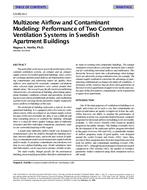Description
The goal of this work was to assess the performance of two common ventilation systems, an exhaust and an exhaust-supply system, in Swedish apartment buildings. Since correct air-exchange and interzonal airflows are important for removing contaminants and improving indoor air quality, these airflows were analyzed by systematic computer calculations when selected input parameters were varied around their default values. The research specifically involved establishing characteristics of a prototypical building, determining appropriate boundary conditions (climate and operation), developing necessary physical/mathematical models, and establishing a protocol for carrying out the parametric studies required to assess airflows in buildings of this type.
The prototypical building represents a typical six-story apartment building. It is equipped with a low-velocity ventilation system, either an exhaust or an exhaust-supply system. Because of the lack of reliable key data, it was a difficult and time-consuming process to establish the building. Although there is a need for better quality leakage data of multizone structures and their individual components, parametric studies are somewhat forgiving in this regard.
A steady-state multizone airflow model was designed to simultaneously solve the airflows through the building envelope, between different zones, and in the duct system. In addition, a contaminant model was developed and coupled with the airflow model. It calculates contaminant concentrations over time in every defined building zone. Model validations show that both models can be expected to produce reliable results.
The study results, though specific for the prototypical building, present useful generalities that allow substitutions to be made in working with comparable buildings. The exhaust ventilation system allows a pressure hierarchy that is beneficial for controlling interzonal airflows and exfiltration. This hierarchy, however, turns into a disadvantage when leakage levels are altered by closing ventilation slots, for example. The exhaust-supply ventilation system has the advantage of guaranteeing a minimum air-exchange rate under all conditions. A drawback of this system is that air flows from apartments on the lower levels to apartments on upper levels via the staircase. Because of this flow pattern, contaminants can be transported to upper-level apartments.
Units: Dual
Citation: Symposium, ASHRAE Transactions, vol. 105, pt. 1
Product Details
- Published:
- 1999
- Number of Pages:
- 12
- File Size:
- 1 file , 620 KB
- Product Code(s):
- D-7607




